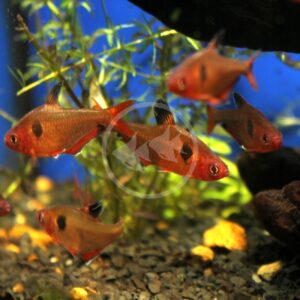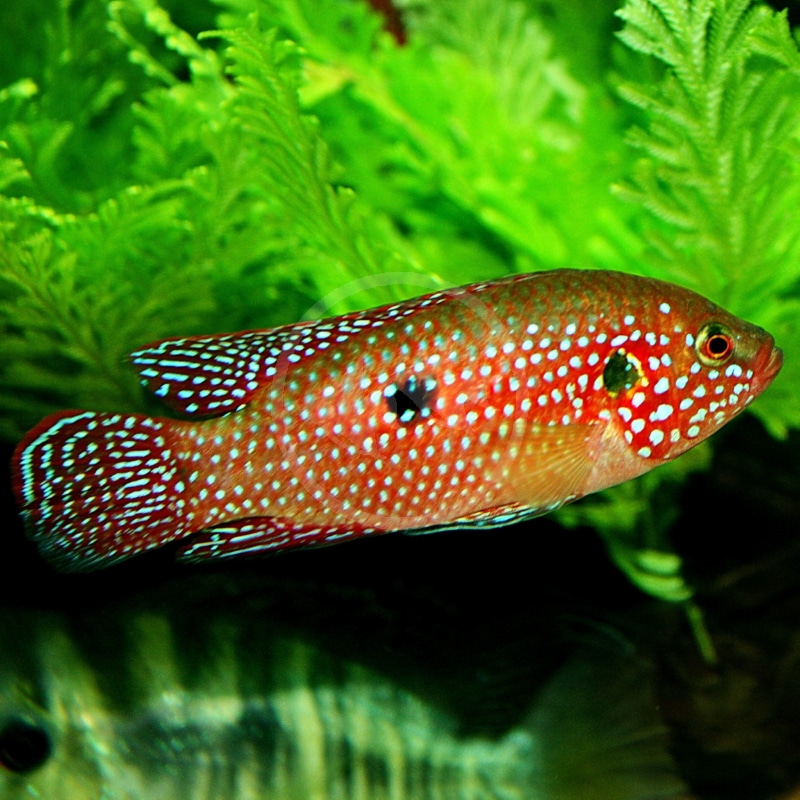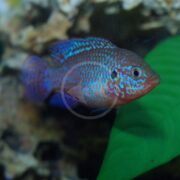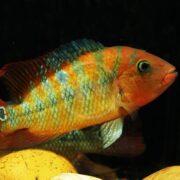
CICHLID – JEWEL BLOOD RED
Hemichromis lifalili
$19.99
The Blood Red Jewel Cichlid, or simply Red Jewel for short, are endemic to slow-moving creeks and tributaries of the Democratic Republic of Congo. The majority of specimens available within the aquarium trade are produced on a commercial basis, however. Both sexes of this species exhibit a rich red coloration with bright metallic blue flecking across the entire body and fins; males can be slightly more colorful during spawning. The Blood Red Jewel should not to be mistaken for the Turkana or Red Dwarf Jewel Cichlid (Hemichromis exsul) which is even more red in color with fewer flecks of blue, in addition to growing to a smaller adult size of 4″ or less in length. Furthermore, the Blood Red Jewel can be distinguished from drab individuals of Turquoise Jewels (Hemichromis bimiculatus) based on the number of black spots on the body; a Red Jewel will have two black spots on their flank, while the Turquoise Jewel will have three due to the additional black spot on the caudal peduncle. A Red jewel can grow to an adult size of approximately 6″.
Care Level: Easy
Temperament: Semi-Aggressive
Live Plant Safe: With Caution
General Description: The Blood Red Jewel Cichlid, or simply Red Jewel for short, are endemic to slow-moving creeks and tributaries of the Democratic Republic of Congo. The majority of specimens available within the aquarium trade are produced on a commercial basis, however. Both sexes of this species exhibit a rich red coloration with bright metallic blue flecking across the entire body and fins; males can be slightly more colorful during spawning. The Blood Red Jewel should not to be mistaken for the Turkana or Red Dwarf Jewel Cichlid (Hemichromis exsul) which is even more red in color with fewer flecks of blue, in addition to growing to a smaller adult size of 4″ or less in length. Furthermore, the Blood Red Jewel can be distinguished from drab individuals of Turquoise Jewels (Hemichromis bimiculatus) based on the number of black spots on the body; a Red Jewel will have two black spots on their flank, while the Turquoise Jewel will have three due to the additional black spot on the caudal peduncle. A Red jewel can grow to an adult size of approximately 6″.
Diet Requirements: An omnivorous cichlid, Red jewels will accept a wide range of prepared aquarium diets such as flakes and pellets specifically designed for cichlids. A slowly sinking pellet or granule can work best for these mid to bottom dwellers. For variety they will also feed on frozen foods such as brine shrimp with Spirulina, mysis shrimp and other blends for freshwater omnivores.
Care Requirements: A minimum tank size of 55 gallons would be suggested for a pair of these cichlids. A relatively peaceful African cichlid, Red jewels are well suited for the semi-aggressive community aquarium and with moderately sized active fish. This species absolutely requires a well-oxygenated aquarium. Although they can be social with each other while young, a breeding pair of adults can become territorial and aggressive towards tank mates. Providing additional space can help mitigate this. They can be kept with well established, hardy, aquarium plants with caution as they may do some digging (especially if spawning) and nip at more fragile plant leaves. Recommended water conditions are slightly alkaline for best coloration, 75-79° F, KH 10-15, pH 7.5-8.5.
Purchase Size: Large: 3” to 4”
Note: Your item may not look identical to the image provided due to variation within species. Purchase size is approximate.
Dry goods orders are shipped via US Postal Service or UPS to the address provided at checkout based on the selection made in your website shopping cart. Product is carefully packed to help prevent any damage during shipping. Once processed you will receive a shipment notification via email with tracking number, and delivery notification. Please allow 48 hours for processing after your order is placed.
Perishable items (i.e. live plants, refrigerated/frozen foods) are shipped via US Postal Service 2-3 day to the address provided at checkout for a $25.00 flat rate charge. Items are packed with secure packing material and heat, cold, or Cryo packs as needed to maintain safe temperatures during transit. If one or more perishable items are in the shopping cart at checkout the $25.00 perishable shipping charge will automatically appear and need to be selected. Once processed you will receive a shipment notification via email with tracking number. Please allow 48 hours for processing after your order is placed.
Livestock (i.e. fish, invertebrates, coral) are shipped via UPS Overnight to the address provided at checkout for a $55.00 flat rate charge. Livestock is packed in insulated styrofoam boxes with secure packing material and heat, cold, or Cryo packs as needed to maintain safe temperatures during transit. If one or more livestock items are in the shopping cart at checkout the $55.00 livestock shipping charge will automatically appear and need to be selected. Livestock is shipped Monday through Wednesday ONLY (no weekend delivery is available) weather permitting, and we reserve the right to delay shipping until conditions are appropriate for safe arrival. Once your order is placed we will contact you to arrange the best shipping date based on these criteria. Someone must be available to receive the livestock order on the first delivery attempt. Once processed you will receive a shipment notification via email with tracking number. Please allow 48 hours for processing after your order is placed.
For mixed dry goods/perishable & livestock orders items will be shipped via their corresponding shipping methods outlined above. Dry goods will be shipped via US Postal Service or UPS based on your selection and checkout, while livestock will ship via UPS Overnight for a $55.00 flat rate charge. You will receive separate notifications and tracking numbers for the dry goods and livestock. Please note due to different carriers and shipping methods dry goods and livestock may arrive on different days.
Related products
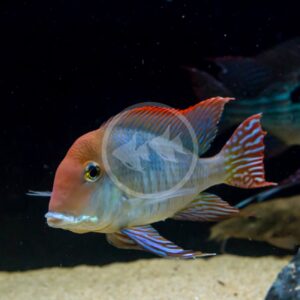
CICHLID – GEOPHAGUS TAPAJOS RED HEAD
Geophagus pyrocephalus
$19.99 – $69.99Price range: $19.99 through $69.99
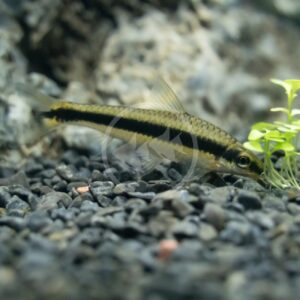
ALGAE EATER – SIAMESE / SAE
Crossocheilus oblongus
$7.99 – $24.99Price range: $7.99 through $24.99

PLECOSTOMUS – BRISTLENOSE ALBINO / GOLD
Ancistrus sp.
$5.99 – $59.99Price range: $5.99 through $59.99
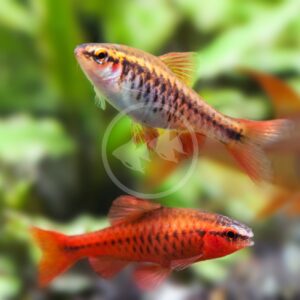
BARB – CHERRY
Puntius titteya
$3.99 – $9.99Price range: $3.99 through $9.99
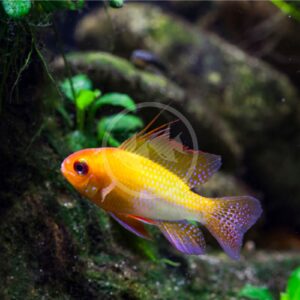
CICHLID – RAM GERMAN GOLD
Mikrogeophagus ramirezi
$5.99 – $26.99Price range: $5.99 through $26.99

ANGELFISH – FW SILVER
Pterophyllum scalare
$9.99 – $39.99Price range: $9.99 through $39.99
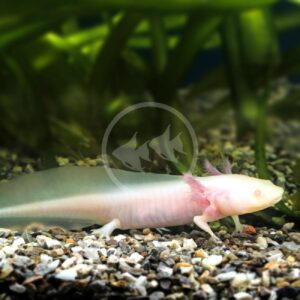
AXOLOTL – ALBINO
Ambystoma mexicanum
$99.99 – $149.99Price range: $99.99 through $149.99
